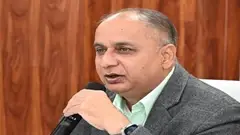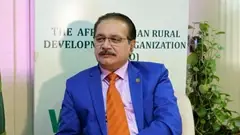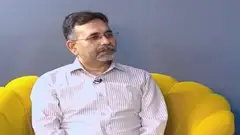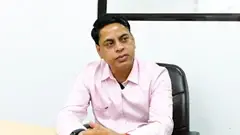
Born in a village in Karnataka, Dr. M.B. Chetti went on to become one of the most prominent figures in the world of agriculture. Today, he is the Vice Chancellor of University of Agricultural Sciences, Dharwad. Formerly, he was the Assistant Director General, Education Division of Indian Council of Agricultural Research.
Fuelled by his passion for academia, Dr. Chetti moved to the United States after earning his degree in M.Sc. in 1981. From 1985 to 1987, he remained a post-doctoral fellow at the University of California, USA. Again, between the years 2004 and 2005, he received a Certificate of Training from McGill University, Canada.
Dr. Chetti has served at several positions since the inception of his long and remarkable career. He has been an associate professor, professor, university head, registrar, university librarian, and has worked in a number of other capacities at some of the most respected Indian institutions. Choosing academia over money, Dr. Chetti has been a guide and inspiration to many students.
Krishi Jagran’s Shruti Joshi Nigam spoke with Dr. M.B. Chetti for a special session on canopy management in perennial horticulture crops.
Krishi Jagran: How is canopy management better than traditional farming methods and what are its advantages?
Dr. M.B. Chetti: Canopy management is for the horticulture sector and in that too, particularly for perennial crops. Perennial crops, unlike annual crops, are those which do not require to be replanted every year. They grow back again after every harvest. Examples include mango, guava, peach, plum, pear, apple, and more. Canopy management is of great importance for such perennial crops.
I would like to give the simple example of mango trees. In today’s time, farmers have become more informed. However, earlier there wasn’t enough research about horticulture. Back when I was born, there used to be, say, 500 mango trees in one acre of land. The quantity of fruits these 500 trees produced was very less. In horticulture, we use the term “source and sink.” A source is a location in a plant where water and other nutrients are taken up or synthesized (leaves). A sink is a location where these resources are used (flowers and, eventually, fruits). There is a relation between the source and the sink: the amount of resources taken up by the source must be equal to the one utilized by the sink. If we talk about the farmers of Kashmir and Himachal Pradesh, for instance, we see that they have received training and have learnt to maintain the correct ratio in their trees, which has led them to produce bigger yields.
Mango is cultivated on a large scale in Dharwad, Karnataka. To have a very good harvest, it is important to prune them and remove those branches which bear fruits only every alternate year or bear no fruit at all. It is also important to remove extra leaves in order to maximize the utilization of sunlight and prevent the growth of insects. Here, I would like to cite an example. Many years back, our university had developed a chikoo hybrid which was also cultivated by framers in the area. They earned a lot of profit from these trees but about a decade ago, some of the farmers approached us and said that they were no longer bearing fruits. We formed a committee of experts and went to inspect the trees. We found them so overgrown that they had started shedding flowers as the sunlight was not reaching their branches. We advised the farmers to cut some of the branches from the top.
Therefore, it is very important to trim the trees which are in dormant state. It is also to be noted that this must be done at a particular season: when there is no rainfall, usually in October. Or, in case of north-east rainfall, the trees could be pruned in March or April. It is imperative that they be pruned when there is no rainfall. For trees that are very old, there is a technique which involves removing all the branches and only keeping the trunk. However, this must be learnt from experts. In fact, every tree has a specific length to which it must be pruned. Furthermore, there are some chemicals which are applied to the trees after the pruning is done. They also must be watered once after they are pruned.
What would happen if canopy management is not practiced?
Dr. Chetti: It is very simple: the trees would not give a good yield. It is the aim of every farmer to have bigger yield and maximize profits. Moreover the tree would require the application of more nutrients and water if canopy management is not done.
Do the farmers need to train themselves for canopy management?
Dr. Chetti: Indeed. Canopy management does not mean that any or every branch has to be removed. The farmers need to cut selected branches, and with a saw. This is to ensure that the cut which is being made is sharp. In case the tree is not cut properly, it gets wounded and becomes more susceptible to insects and diseases. The farmers would understand this only by seeing how it is done. Therefore, demonstration is very necessary.
Can the farmers get trained at Krishi Vigyan Kendra (KVK)?
Dr. Chetti: Indeed, they can get training at each and every KVK. There are 721 KVKs in the country at the moment. KVKs essentially have horticulturalists because horticulture is a very important occupation in today’s times. KVKs are doing a very commendable job by giving training to farmers about every aspect of agriculture, from coconut cultivation to product making.
Is the method of canopy management different for every tree?
Dr. Chetti: Yes. What I am telling here are the basic principles of canopy management. In fact, canopy management is done by looking at the canopy. However, there is one general rule for canopy management: sunlight should reach every leaf on the tree.
There are two kinds of canopy: open canopy and closed canopy. In open canopy, the leaves are not uniformly distributed. In closed canopy, the leaves are so evenly distributed that light falls on the leaves, and not directly on the ground. The latter type is considered best because all the leaves receive sunlight.
According to agriculture department, in the years 2020 and 2021, around 320 million tonnes of horticulture crops shall be produced in the country. What are your comments?
Dr. Chetti: 2021 is the international year of fruits and vegetables. So we have to commit ourselves to learn more about fruits and vegetables.
India has become an important exporter of spices during the Covid-19 pandemic. How can the canopy management of spice-producing trees be done?
Dr. Chetti: There are spice trees which are larger. Examples are clove and cinnamon trees. Canopy management must be done for these trees as well.
What are the mistakes farmers should avoid while practicing canopy management?
Dr. Chetti: Proper spacing must be maintained between trees. The parameters for this are fixed and differ from tree to tree. Furthermore, as I have already explained, pruning must be done during the right season. The methods of pruning are also decided by experts and must be followed for best results.
Do climatic and environmental conditions of different regions also impact these standards?
Dr. Chetti: The basic principles of canopy management remain the same in different region. The most determining factor everywhere is the size of the plant.
Organic farming has gained popularity recently. How is it better than traditional farming methods?
Dr. Chetti: Basically, the farming which was done in the olden times was organic farming. Chemicals were introduced for increasing yields much later. However, while using chemicals, we forgot soil health. In my personal opinion, the satisfaction and quality farmers can get from organic farming cannot be matched by inorganic farming.
It is to be noted that framers would not see the benefits for the first two or three years. This is the time it takes for the soil quality to be replenished. Once it is replenished, he plants would start warding off insects and become more resistant. Organic farming combined with modern research and techniques can prove to be very beneficial for the farmers.
Note: This interview has been edited and condensed for clarity purposes.
















Share your comments